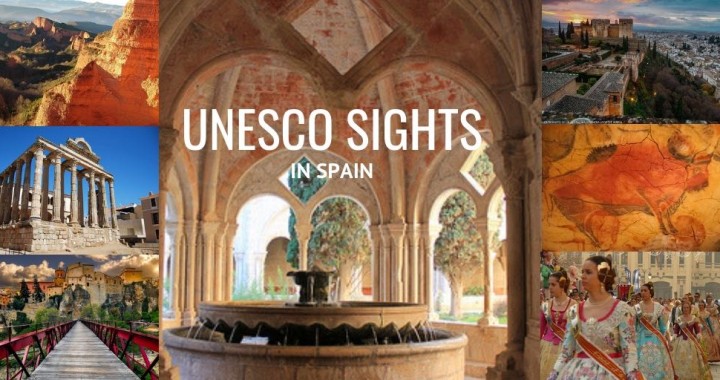Looking for a private custom trip to Spain that features Spain’s UNESCO World Heritage sights in charming destinations that ooze with character, history and style? Spain’s UNESCO Sights are must-sees – not only for their integral beauty and heritage but because they are also authentic bustling cities where people live, work and go to school. We challenge you not to be charmed – your only problem will be deciding which to include in your itinerary! And that’s where we, the expert travel advisors at Totally Spain can come in handy. Hope you enjoy our useful guide.
Spain’s UNESCO World Heritage Sights
Visiting Madrid? Why not check out a few of these UNESCO sights?
1. El Escorial in the region of Madrid
Built for Phillip II, this castle and monastery completed in 1584 was designed to showcase the monarch, the country and the might of Catholicism to the rest of the world. It’s scale and architectural and artistic wealth is significant. Where else will you find 15 cloisters, 13 oratories, 86 staircases, 88 fountains, 9 towers, 73 sculptures, 40,000 books (the library here is amazing) and 1,600+ paintings? And the Royal Pantheon is a great way to learn about of the Spanish Hapsburg and Bourbon royal families. For more on Spain’s castles, read our guide here. El Escorial has been part of Spain’s UNESCO listings since 1984.
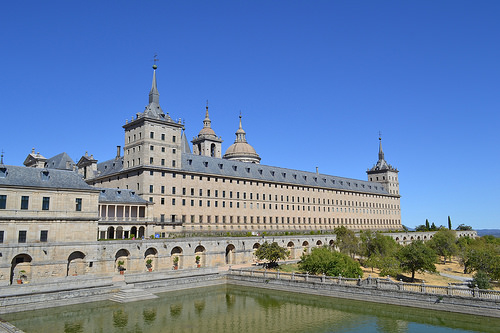
El Escorial is on a totally different scale to anything else you’ve seen! photo credit: Alan Cordova DSC_0084 via photopin (license)
2. The old quarter of Avila and the city walls, Castile-Leon
A city that is beloved by meat-lovers, fans of Saint Teresa and anybody who enjoys walled cities. These walls that act as a perimeter for the city centre feature no less than 2,500 battlements, 87 towers and 9 gates! Learn about Spain’s St Teresa of Avila who established her ‘barefoot’ or Discalced Carmelite convents. We recommend visiting the 17th century Convent of St Teresa where she was born. The museum there offers a number of relics including one of her fingers alongside a cradle, sandal and rosary beads. And before you leave, order a meal of Iberian Avileña-Black bred beef at one of the many local taverns! Read about Spain’s wonderful walled towns and cities here. Avila has been part of Spain’s UNESCO listings since 1985.
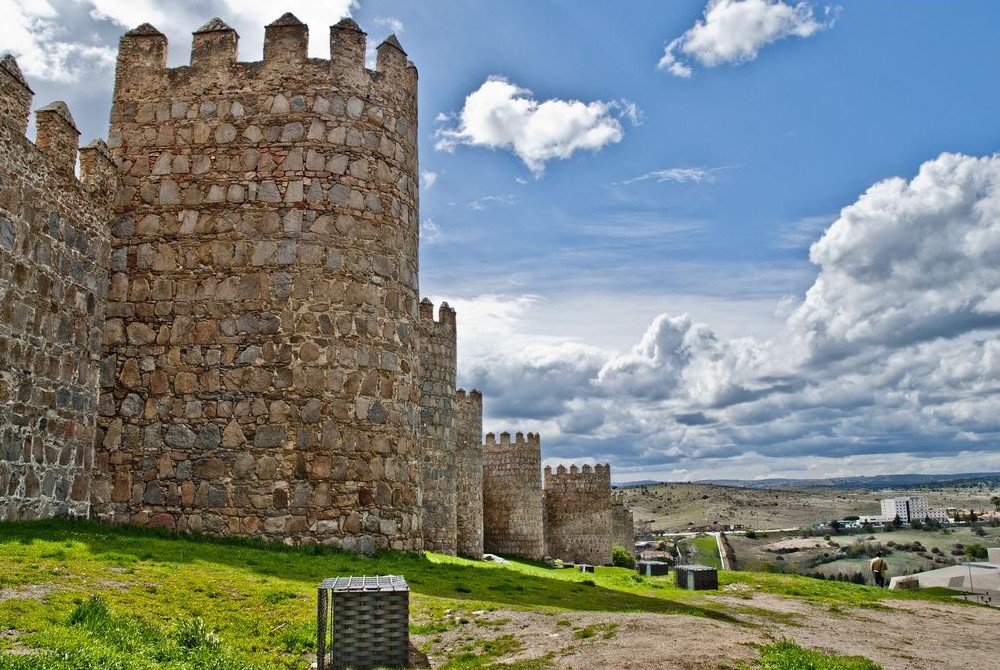
These 12th century walls of Avila have been listed as a national monument since 1884. Photo credit: Murallas de Ávila via photopin (license)
3. The historic city of Toledo, Castile la Mancha
One of the most popular day trips from Madrid, Toledo is known as the City of Three Cultures referring to the historical co-existence of Jewish, Muslim and Christian cultures. It was also the capital of unified Spain after the Reconquista – up until Phillip II moved his court to Madrid in 1561. El Greco lived and worked here and you’ll be able to enjoy his masterpieces here also. Read about his most famous painting The Burial of the Count of Orgaz (1588) which is on show in Toledo, in our guide to Spain’s most famous paintings here. Toledo has been part of Spain’s UNESCO listings since 1986.
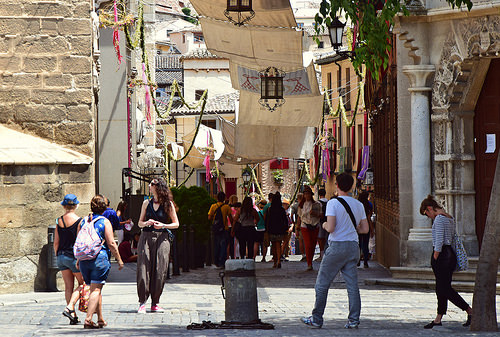
Toledo hasn’t been the capital of Spain since 1561 but you don’t have to work hard to imagine it back then as you walk the streets today. photo credit: kadege59 Toledo via photopin (license)
4. Old City of Salamanca, Castile-Leon
This university city first enrolled students back in 1094. We love visiting the Clerecia Tower near the House of Shells, walking over the Roman bridge, visiting the two cathedrals that sit side by side and spending time in the 18th century Plaza Mayor – one of Spain’s most dazzling squares. See more of Spain’s best plazas here. Salamanca has been part of Spain’s UNESCO listings since 1988.
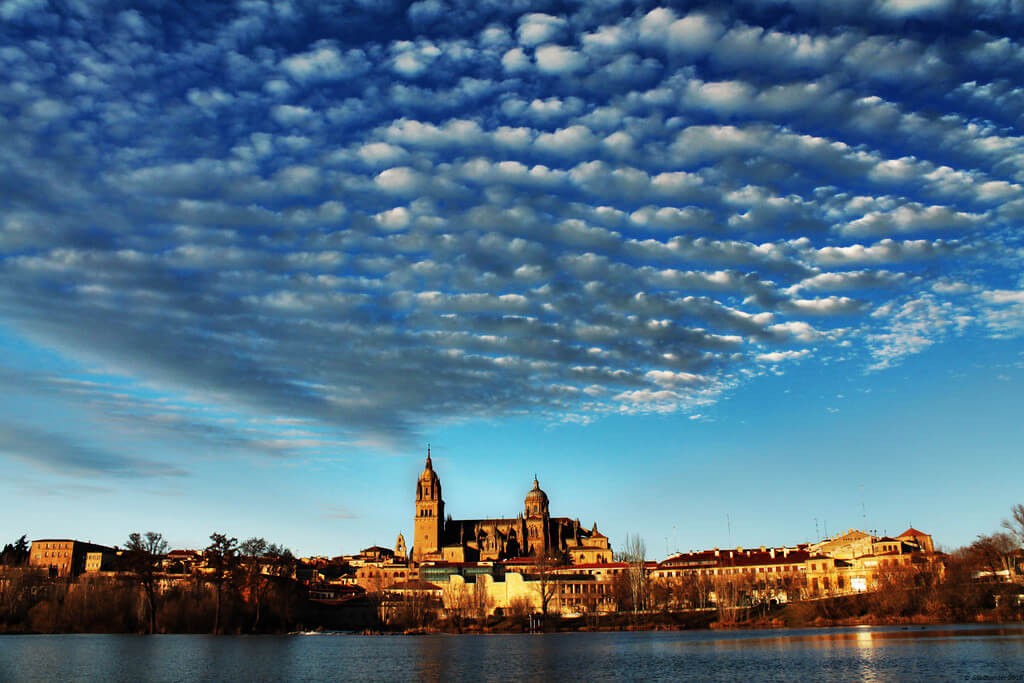
The skyline in Salamanca with the stunning spires in the distance. photo credit: catedral vieja via photopin (license)
5. Cuenca, Castile la Mancha
Perched on the top of a rocky hill, Cuenca is famous for its hanging houses called the ‘Casa Colgadas’ which are built into the rock face. After walking this bridge, visit the Parador – a former Dominican monastery, and the wonderful Plaza Mayor, dominated by the Gothic cathedral, Nuestra Senora de Gracia. For more ideas on day trips from Madrid, see our guide here. Cuenca has been part of Spain’s UNESCO listings since 1996.
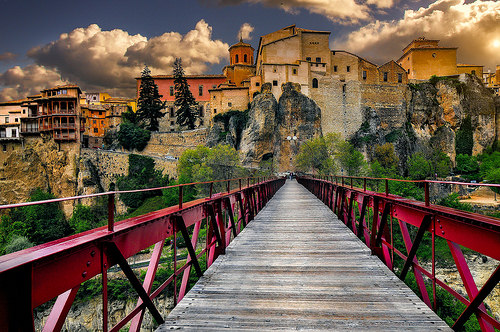
The best view of the hanging houses in Cuenca is from this footbridge built in 1902. photo credit: Luciti Cuenca via photopin (license)
6. The old city of Segovia and the Aqueduct, Castile-Leon
The golden hues of this UNESCO-listed city and its Roman aqueduct are dazzling by day and by night. The Roman Aqueduct was built in the year 50 AD! Segovia’s Alcazar dates from the 11th to the 19th centuries and is well worth a visit – along with the 16th century Gothic cathedral – and the Jewish Quarter. Seek out the Corpus Christi church which was the main synagogue in Segovia until 1410. If you’d like to know more about Jewish sights in Spain, read our guide here. Segovia has been part of Spain’s UNESCO listings since 1985.
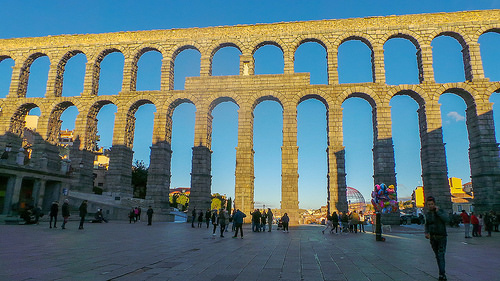
Built in the year 50 AD without the use of mortar or cement and still standing strong today! photo credit: El Coleccionista de Instantes Segovia La Ciudad Vieja y El Acueducto via photopin (license)
7. University and the historic quarter of Alcala de Henares, the region of Madrid
First port of call is the university founded by Cardinal Cisneros in 1499. Start out with a tour of the Colegio Mayor de San Ildefonso from 1537 and keep an eye out for the many storks and their nests on the nearby towers and steeples! Cervantes, the writer of Don Quixote and Sancho Panza was born here in Alcala in 1547 and the Cervantes Prize for Literature is awarded every April in the Paraninfo building. You can also visit Cervantes’ birthplace on Calle Mayor – which is one of the prettiest arcaded streets in all of Spain. Check out more of Spain’s best university cities here. Alcala de Henares has been part of Spain’s UNESCO listings since 1998.
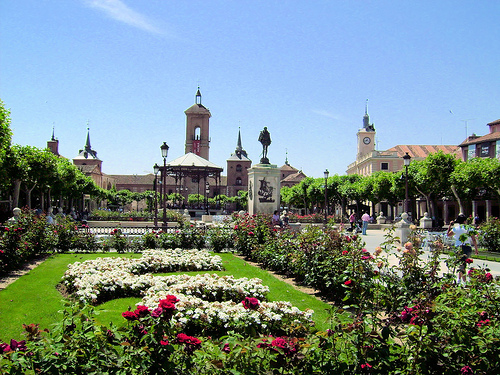
The square dedicated to Cervantes in his place of birth – Alcala de Henares. photo credit: Daniel Rocal Plaza de Cervantes via photopin (license)
Visiting Andalusia? Why not check out a few of these UNESCO sights?
8. The Alhambra in Granada, Andalusia
Set on a wooded hill above the city of Granada, in Andalusia in Southern Spain, the Alhambra Palace was built in the 14th century by the then sultans of Granada, rulers of the last Muslim kingdom in Al-Andalus. It reveals the brilliance and spirit of the Moorish culture in Andalusia at a time when the rest of Europe was only just beginning to emerge from the Dark Ages. This is Spain’s best-known UNESCO sight and we’ve written a detailed guide to visiting this monument which is very very busy – so heed our advice and book in advance – or ever better – get us to plan a trip for you! The Alhambra and the Generalife have been part of Spain’s UNESCO listings since 1984 and in 1994 the listing was extended to the Albaicin neighbourhood in Granada.
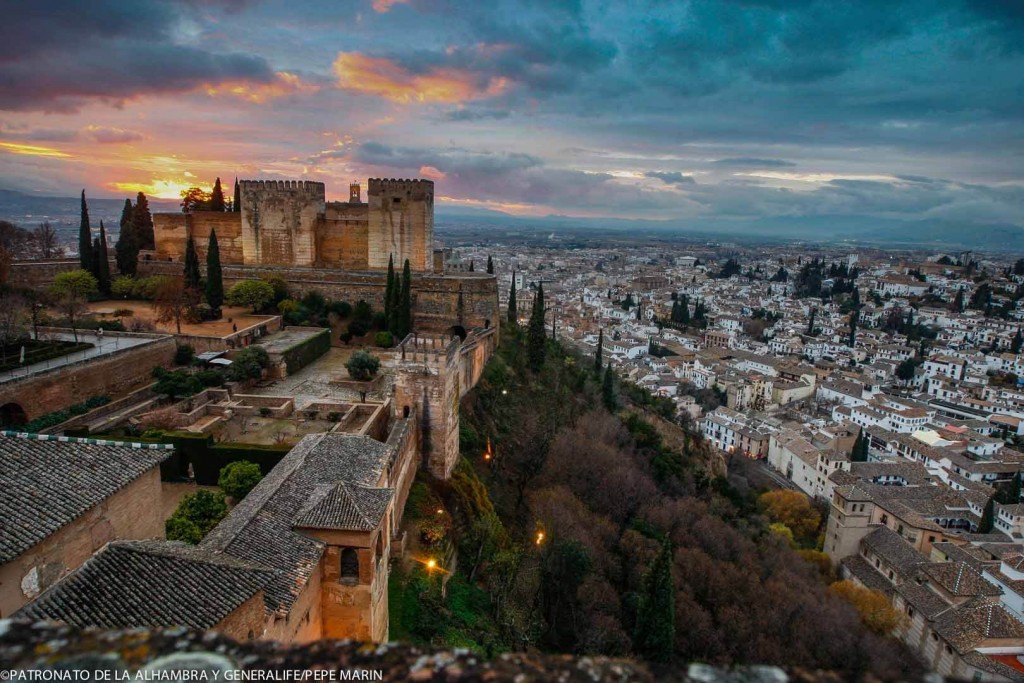
Whatever angle you look at it from, the Alhambra is a tremendous sight. Pic: Pepe Marin/Patronato de la Alhambra y Generalife
9. Seville’s Alcazar, Cathedral & Archivo de las Indias, Andalusia
The 9th century Alcazar is the oldest active royal palace and gardens in Europe and is conveniently close to Seville’s cathedal and Giralda tower which is another must-see in Seville. The cathedral was built on the site of a former mosque, making it the largest Gothic cathedral in the world. It’s also the burial site of Christopher Colombus who docked here on his return from the Americas. Climb the Giralda bell tower where the views of the city are wonderful and as you exit, visit the Patio de los Naranjos (Orange Courtyard). And nearby is the ancient Lonja, which became the Archivo de Indias, containing valuable documents from the archives of the colonies in the Americas. Read our guide to Andalusia’s must-sees here. Seville has been part of Spain’s UNESCO listings since 1987.
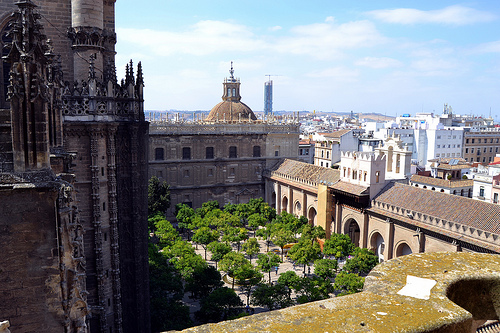
Yes – those are orange trees alongside Europe’s largest gothic cathedral – in Seville! photo credit: Emilio__ Patio de la Catedral via photopin (license)
10. The historical centre of Cordoba & its Courtyard Festival, Andalusia
Cordoba’s period of greatest glory began in the 8th century after the Moorish conquest, when mosques, palaces and public buildings were built to rival the splendours of Constantinople, Damascus and Baghdad. In the 13th century, under Ferdinand III, Cordoba’s Mezquita was turned into a cathedral and the combination of architectural styles – still visible today- is dazzling. Nothing can prepare you for the columns inside. We also recommend the 14th century former Jewish synagogue. And the scent of the oranges in the Patio de los Naranjos or the 12 courtyards of the 14th century Viana Palace. And of course – there’s the amazing Patio Festival in May which is also UNESCO-listed. It’s really magical to push open the huge wooden plinths of doorways and find yourself in the city’s unique competition gardens. A real once-in-a-lifetime experience! Toledo has been part of Spain’s UNESCO listings since 1984 and the listing was extended to cover the historic city in 1994. The Courtyard Festival was listed in 2012.
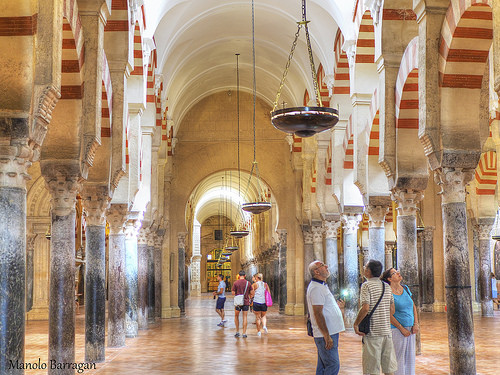
This former mosque in Cordoba is now a cathedral – and the combined influences are astounding! photo credit: Manolo Barragan Orozco Mezquita Catedral de Cordoba via photopin (license)
11. The old city of Caceres, Extremadura
Strolling around the old town of Caceres is like walking through the history of the middle ages. You’ll love Plaza San Mateo and Plaza Santa Maria. And those travelling with children might enjoy trying to capture each of the 30-plus towers from the Muslim period of rule. Caceres has been part of Spain’s UNESCO listings since 1986.
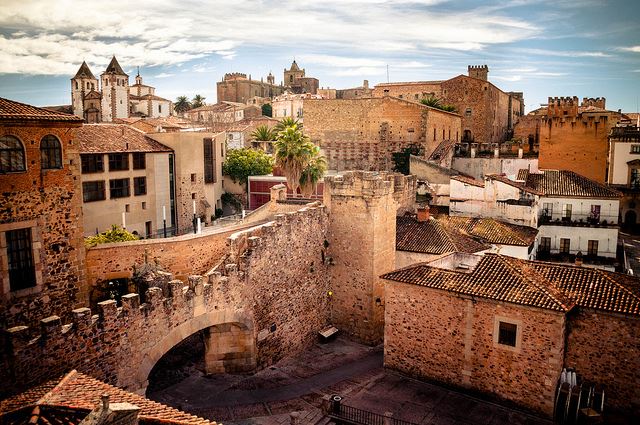
Caceres – where architecture tells the history of a city perfectly. Photo credit: Twisen33 via photopin cc
12. Merida city in Extremadura
Such beauty and majesty awaits in this city that dates back to 25 AD! Its Roman treasures include the Temple of Diana, the amphitheatre, the Roman theatre, the 792 metre long Roman bridge and the Concatedral of Santa Maria are all worthy of your time. We often jest that going to Merida is like visiting Rome but without the crowds! Merida has been part of Spain’s UNESCO listings since 1993.
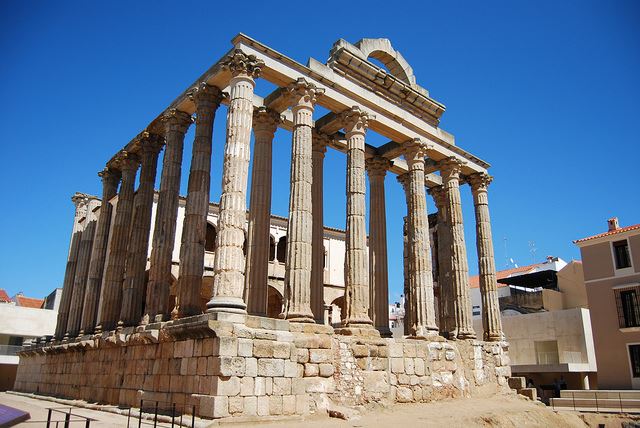
photo credit: Rocío Martínez P. via photopin cc
13. The Royal Monastery of Guadalupe, Extremadura
Not only an exceptional architectural site where you can examine sections from each century dating back to the 1300s, but you can also enjoy wonderful artwork by Zurburan, El Greco and Goya. This is one of the lesser known UNESCO sights so chances are you’ll get to enjoy the space with relative peace and quiet. Read our guide to exploring Extremadura here. The Royal Monastery has been part of Spain’s UNESCO listings since 1993.
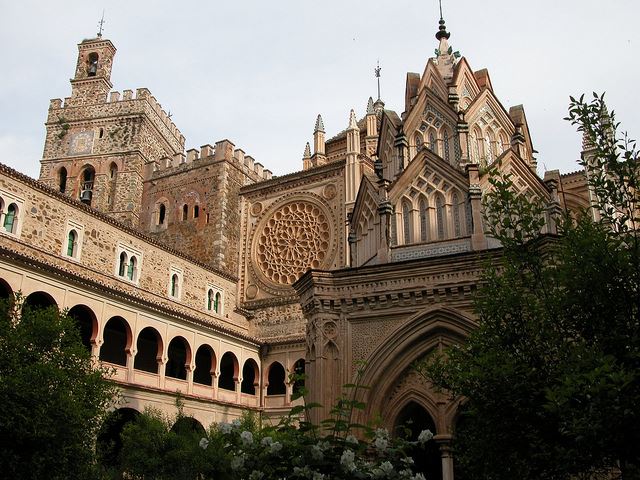
The Royal Monastery of Santa Maria de Guadalupe. Photo credit: james_gordon_losangeles via photopin cc
14. Doñana National Park, Andalusia
If you need a bit of a horizon after all these buildings and cities, luckily for you UNESCO gave the thumbs-up to this national park’s 542 square kms which is made up of marshlands, lagoons, woodlands and sand dunes. More than half a million birds spent their winters in Doñana each year and we recommend exploring the 38 km of pristine beaches and going inland to enjoy the flamingos and to catch a sighting of the Iberian lynx, the imperial eagle, the marble teal and the white-headed duck. Read about Spain’s top national parks here. Doñana has been part of Spain’s UNESCO listings since 1994.

The flamingos are easy to spot in Donana! photo credit: Porphyrio P1020780_3840 via photopin (license)
Visiting Northern Spain? Why not check out a few of these UNESCO sights?
15. Burgos Cathedral in Burgos city, Castile-Leon
What makes this cathedral one of Spain’s best-loved churches? For some it’s a museum to Gothic architecture. For others it’s not the style but the content – from stunning carvings, the golden staircase, the stained glass, the cupola, El Cid’s tomb and the Star of David – all are stunning. The scale and craftsmanship throughout this UNESCO-listed church is both humbling and overwhelming. Construction started on the current structure in 1221 and it began operating as a working church in 1260 when the high altar was consecrated. Building continued for another three centuries until 1567. You’ll see lots of Camino pilgrims in the area because Burgos is on the French Way. To read about our favourite Spanish churches, read our guide to Spain’s cathedrals here. Burgos Cathedral has been part of Spain’s UNESCO listings since 1984.
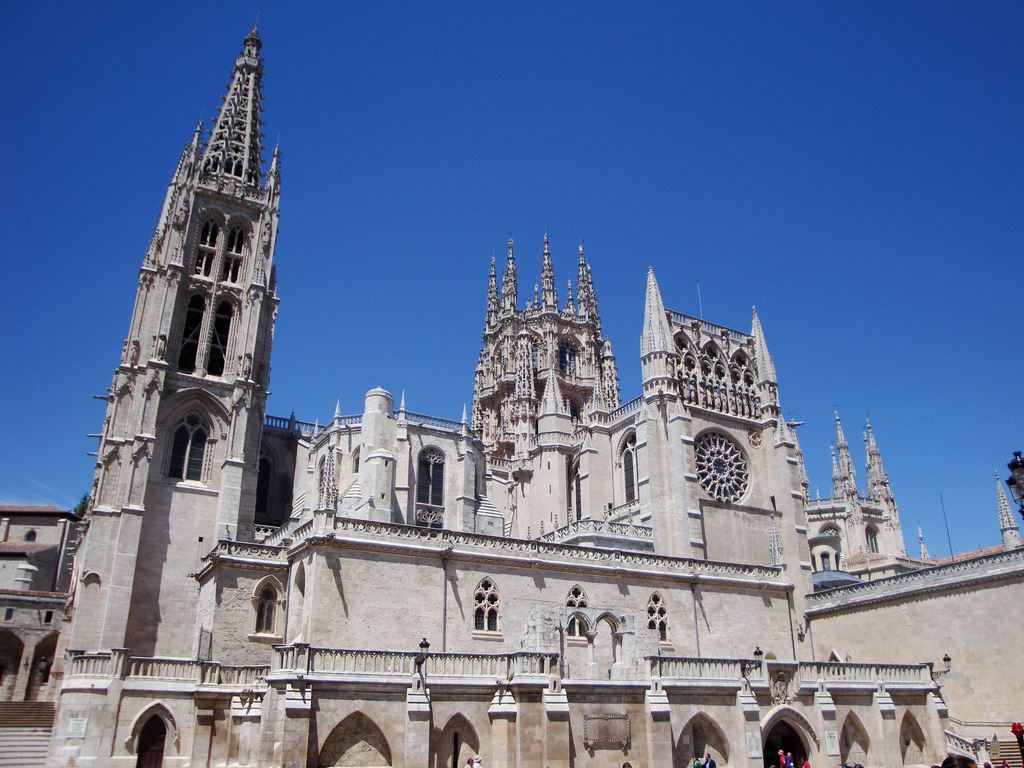
So much to see – it doesn’t fit in one photo! The Cathedral in Burgos. Photo credit: BURGOS 274 via photopin (license)
16. The old quarter of Santiago de Compostela, Galicia
After Rome and Jerusalem, Santiago de Compostela is the most important Christian place of pilgrimage. The relics of the apostle Saint James are said to be kept in the cathedral and you have probably heard about the enormous thurible (called a botafumeiro) that flies over the heads of the pilgrims at high speed. The granite-faced Romanesque structure dates from 1075 but it’s the later add-ons such as the Baroque façade on Obradoiro Square that most of us associate with this cathedral. Being a university city, Santiago is buzzing all year round with students – and of course the Camino pilgrims exploring the Old Quarter which is bustling with little shops, cafés and great bars offering many tasty treats and mouth-watering seafood restaurants. Read our guide to Galicia here. Santiago has been part of Spain’s UNESCO listings since 1985.
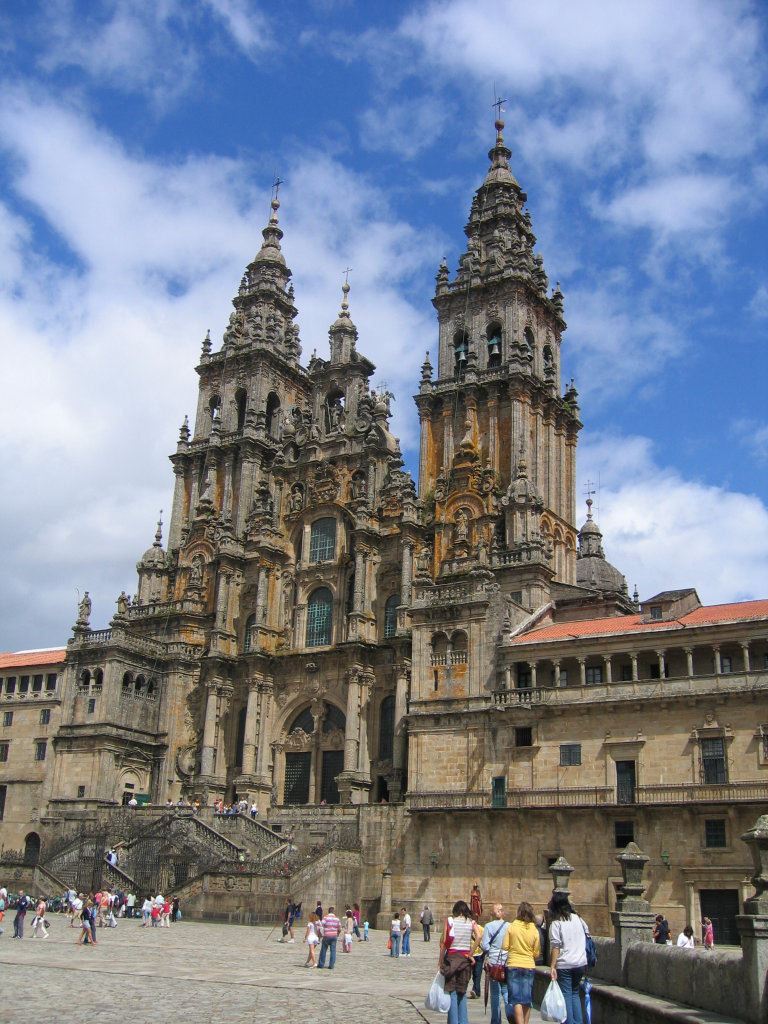
Santiago’s Plaza del Obradoiro and its Romanesque cathedral which dominates the square and the city. Photo credit: Catedral de Santiago de Compostela via photopin (license)
17. The caves of Altamira in Cantabria (and the Northern caves of Spain)
The original Altamira cave – nicknamed the Sistine Chapel of Pre-history – was discovered in 1879 and has been described by the World Heritage Convention as offering “masterpieces of creative genius and humanity’s earliest accomplished art”. It is closed to the public for conservation reasons since 2001 when a replica was built but every Friday a number of lucky ticket holders to the replica are granted access to the original cave via a Lottery system.
Not feeling lucky? We are big fans of El Castillo cave, discovered in 1903. The cave visit covers about 275m and contains 225 animal figures including animals such as horses, bison, stags, goats and mammoths, and another 50 references to the human figure. It is dated back as far as 40,800 years ago – and is open to the public. Read about Cantabria’s caves here. Altamira has been part of Spain’s UNESCO listings since 1985 which was expanded in 2008 to include another 16 Paleolithic caves in Northern Spain.
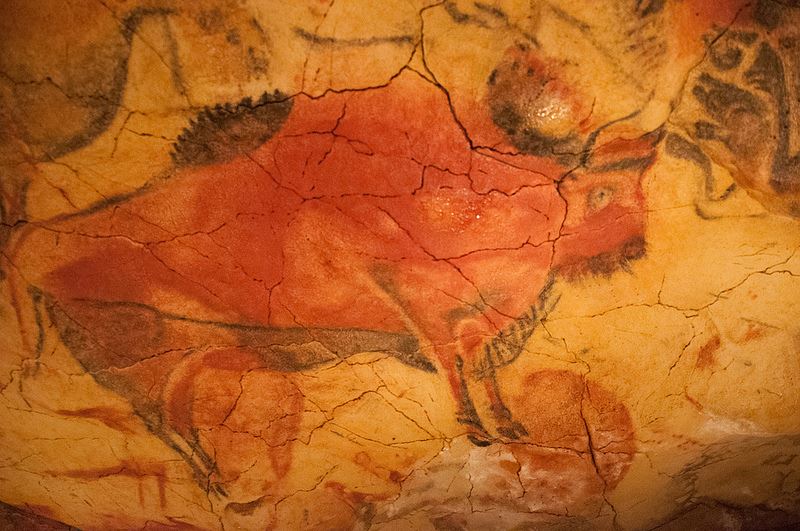
The cave art in Cantabria is truly astonishing – here you can appreciate the image of a bison from Altamira cave! photo credit: Cave Paintings via photopin (license)
18. The Caminos of Santiago – Northern Spain
We organise lots of Caminos for pilgrims that range from a month long itinerary to the shorter final 100km stretch from Sarria to Santiago de Compostela which is the minimum pilgrimage necessary to obtain the Camino certificate. We usually recommend the coastal Northern Way to those who prefer a quieter more contemplative camino as this is a less travelled route – but being further north and along the coastline it can involve a little more rain. If guaranteed sunshine is in order, we’ll steer the peregrino-to-be towards the French way (through Leon and Astorga). This is probably a better route for somebody travelling on their own who’s looking for company as it’s the busier of the caminos. We’ll also listen to other requirements such as the type of accommodation, cuisine or the best bike paths. Read more about how to do the Camino here. The French Camino has been part of Spain’s UNESCO listings since 1993 and was expanded in 2015 to include an additional three routes which making up 1,500km in total.
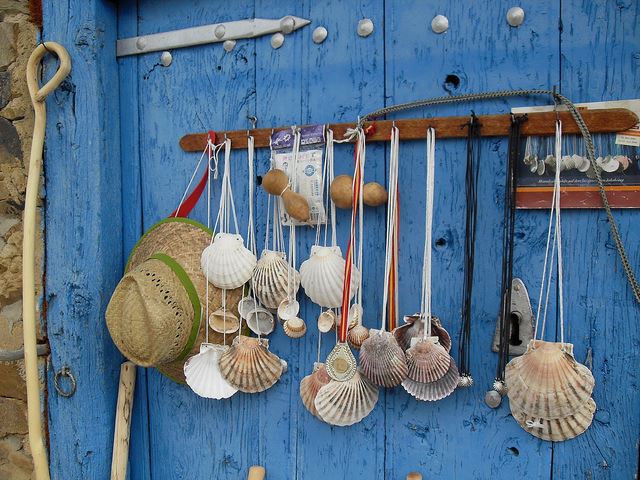
A few Camino mementos in a village outside Astorga. Photo credit: CGPardillos via photopin cc
19. Las Medulas in Castile-Leon
This amazing landscape is the result of Roman gold-mining techniques. The parkland lies within the Bierzo region – which has a great wine tradition. You’ll find an information centre in the town of Las Medulas – from there they can advise you on guided visits, walking, cycling and driving routes. We usually recommend visiting the university city of Leon on the same trip – which is 154km from the Medulas. Pro-tip: If you don’t wish to get behind the wheel yourself in Spain, we can arrange for an expert private guide/driver to drive you around. Las Medulas has been part of Spain’s UNESCO listings since 1997.
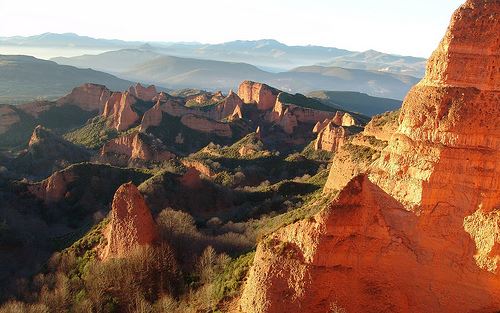
The incredible Medulas de Leon are out of this planet beautiful! Photo credit: Trodel via photopin cc
20. Monasteries of Suso & Yuso in La Rioja
The Suso and Yuso monasteries in San Millan de la Cogolla were declared a world heritage site in 1997. Suso is the older of the two monasteries built by the 6th century Saint Millan. He is credited with the first literature produced in Castilian. In 1053, his remains were transferred downhill to the monastery in nearby Yuso. A further church was added in the 16th century. It’s an interesting visit for anybody interested in architecture, history and the Spanish language – just 35km from Haro and 43km from Logrono – which are also wonderful places to enjoy dome wine-tasting and visit some wineries in La Rioja – read our award-winning guide to the region here. Suso and Yuso have been part of Spain’s UNESCO listings since 1997.
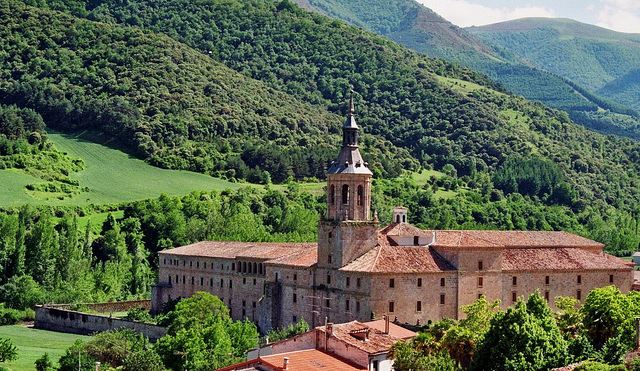
Yuso Monastery in San Millan de la Cogolla – the final resting place for Saint Millan – of great importance to the Spanish and Basque languages. photo credit: byb64 via photopin cc
21. Hercules Tower, A Coruña in Galicia
The Tower of Hercules has served as a lighthouse and landmark at the entrance of A Coruña harbour in north-western Spain since the late 1st century AD when the Romans built the Farum Brigantium. Built on a 57 metre high rock, it rises a further 55 metres, of which 34 metres correspond to the Roman masonry and 21 meters to the restoration directed by architect Eustaquio Giannini in the 18th century, who augmented the Roman core with two octagonal forms. Immediately adjacent to the base of the Tower, is a small rectangular Roman building. The site also features a sculpture park, the Monte dos Bicos rock carvings from the Iron Age and a Muslim cemetery. Read more about A Coruña here. The tower of Hercules has been part of Spain’s UNESCO listings since 2009.
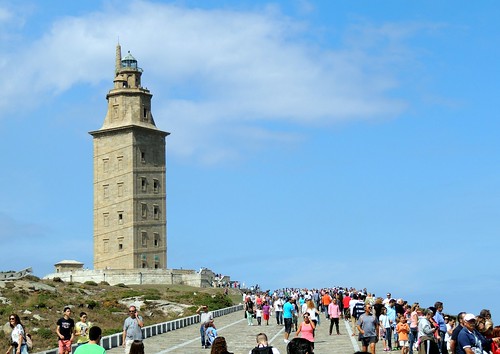
Hercules Tower is a lighthouse dating from the 2nd century near A Coruña in Galicia – and is the oldest Roman lighthouse in use today. photo credit: jl.cernadas 5330-Torre de Hercules (A Coruña) via photopin (license)
22. Viscaya Bridge, Bilbao, The Basque Country
You can walk, cycle or drive onto the oldest hanging transporter bridge in the world and travel over the River Nervion from Portugalete to Las Arenas or vice-versa. The bridge was designed by Alberto Palacio and was opened to the public in 1893. It’s still standing strong at 160m long and 61m high. Read more about Bilbao here and check out our guide to Spain’s best bridges here. Viscaya Bridge has been part of Spain’s UNESCO listings since 2006.
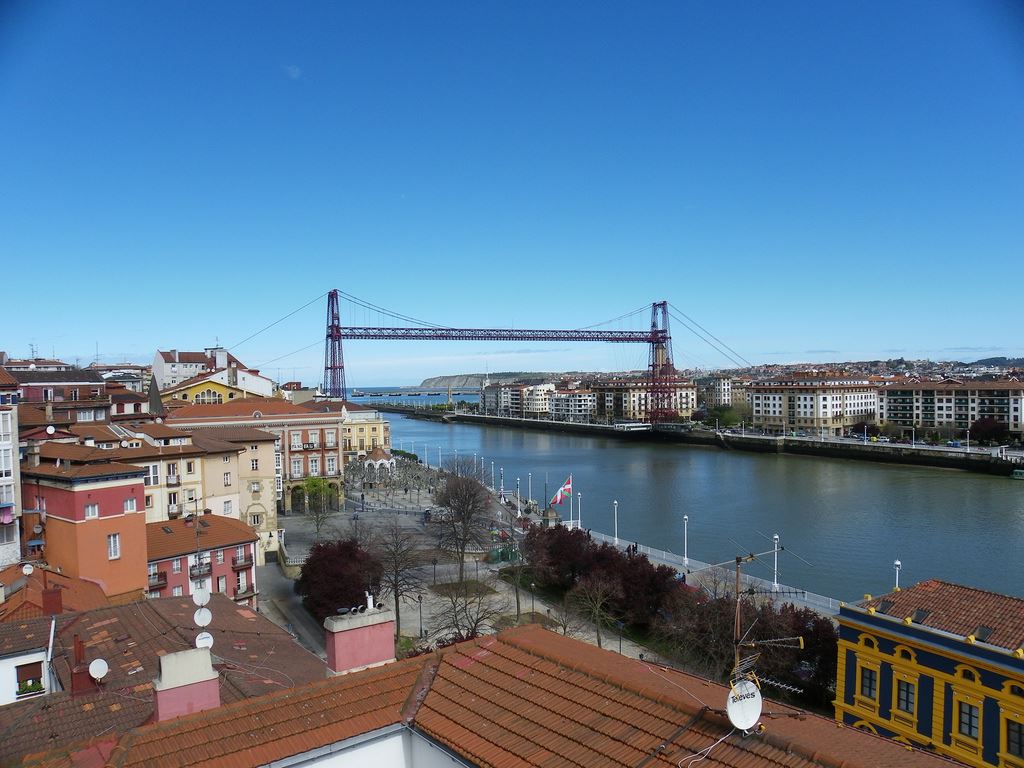
Viscaya Bridge in Portugalete, near Bilbao was completed in 1893. The 45-m-high bridge with its span of 160 m, merges 19th-century ironworking traditions with the then new lightweight technology of twisted steel ropes. It was the first bridge in the world to carry people and traffic on a high suspended gondola! Photo credit: Portugalete, Puente Colgante y Areeta via photopin (license)
Visiting Catalonia? Why not check out a few of these UNESCO Sights?
23. Seven Works by Gaudi in Catalonia
Each year, more and more visitors seek out and enjoy Gaudi’s wildly imaginative creations so – rather like the Alhambra – you really need to plan your visit carefully. The seven buildings are: Parque Güell; Palacio Güell; Casa Mila; Casa Vicens; Gaudí’s work on the Nativity façade and Crypt of La Sagrada Familia; Casa Batlló; Crypt in Colonia Güell. Check out our guide to the key Gaudi sights to make your time in the Catalan capital a little more about the attractions and a little less about the queues! Just four of Gaudi’s designs were part of the original UNESCO listings in 1984. The listing was expanded in 2005 to include Casa Batlló, Casa Vicens and the Crypt in Colonia Güell.
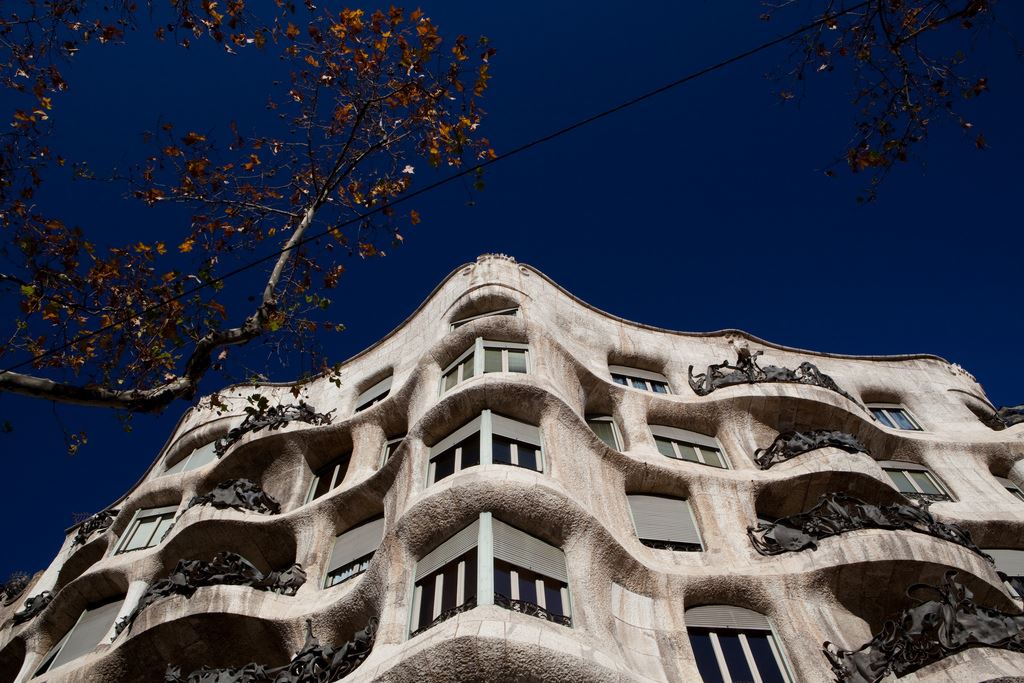
Organic forms dominate at Gaudi’s Pedrera or Casa Mila in Barcelona. Photo credit: IMG_3747 via photopin (license)
24. Mudejar Architecture of Aragon
Aragon’s Mudejar architecture takes us back to the time of complete harmony between Muslim, Christian and Jewish culture in Spain. The Mudejar period in Aragon began in the 12th century and finished in the 17th century when the Mudejars were first forced to convert to Christianity and were ultimately expelled. There are many wonderful Mudejar structures across the region of Aragon – but if you have just one day or two to experience Mudejar architecture, we recommend you visit Zaragoza where you can find at least seven stunning Mudejar buildings within walking distance of each other. Read about these buildings here in our guide to Zaragoza. The Mudejar architecture of Teruel was first listed in 1986 and in the year 2001 the listing was expanded to cover all of Aragon.
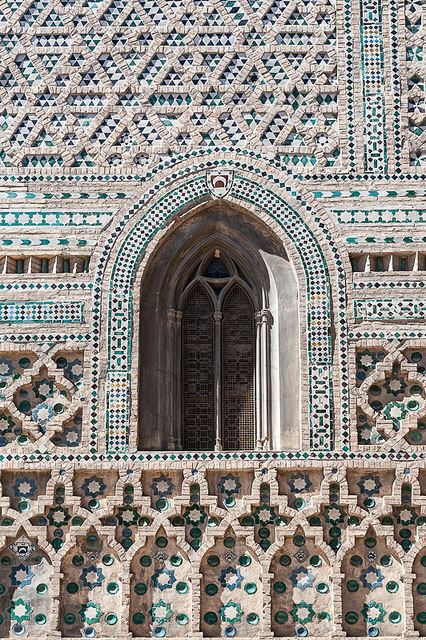
Wonderful brickword on the Mudejar facade at the Seo Cathedral. Photo credit: jacqueline.poggi via photopin cc
25. Poblet Monastery in Vimbodí, Catalonia
Poblet Monastery in the south of Catalonia, is one of the largest and most complete Cistercian abbeys in the world. It was built in the 12th to 15th centuries around a church that dates to the 13th century. It is impressive for the majesty of its architecture and includes a fortified royal residence as well as the pantheon of the kings and queens of Catalonia and Aragon. Poblet’s Monastery has been part of Spain’s UNESCO listings since 1991.
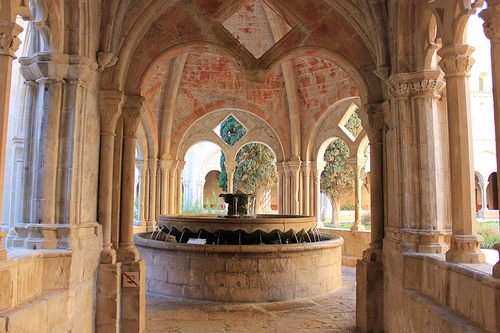
One of the most perfect expressions of Cistercian style – Poblet Monastery in Catalonia. photo credit: fer55. MONESTIR DE POBLET, TARRAGONA 095 via photopin (license)
26. Palau de la Musica Catalana & Hospital de Sant Pau, Barcelona
Don’t think that Barcelona’s architecture begins and ends with Gaudi. You should see the stunning Palau de la Musica from 1908 by the Barcelona-born architect Lluís Domènech i Montaner (1850-1923) – one of the world’s major concert halls and an excellent example of Catalan modernism. For more bucket list ideas from the great buildings of Spain, see our guide to architecture tours in Spain. The Palau and the Hospital has been part of Spain’s UNESCO listings since 1997.
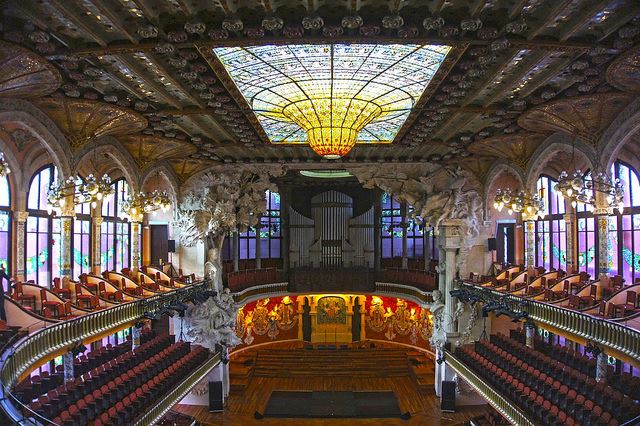
Inside the beautifully decorated Music Hall called Palau de la Musica in Barcelona. Photo credit: Samuel Santos via photopin cc
27. The Silk Exchange & Las Fallas Festival in Valencia City
Valencia city centre is a wonderful combination of Gothic, Romanesque and Renaissance influences and nowhere is that more evident than at the city’s cathedral – but the UNESCO listing gives centre stage to the staggeringly beautiful 15th century Gothic Silk Exchange which is still used for trading today. And it highlights the Fallas Festival – where giant figures called ‘ninots’, made from paper, wax, wood and Styrofoam, are displayed before being burned ceremoniously. If you visit Valencia outside of March, go along to the Fallas Museum to see the ‘ninots’ that have been spared burning. You can also visit the Fallero Guild Museum. For more see our guide to Valencia here. The Silk Exchange has been part of Spain’s UNESCO listings since 1996. The Fallas Festival was added in 2016.
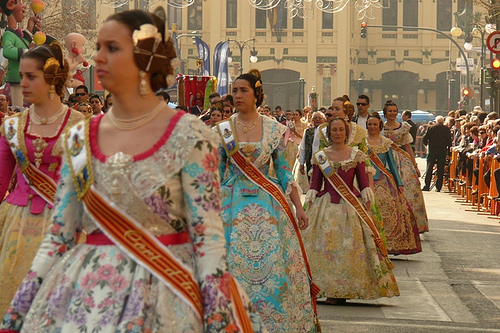
In between the flames and gunpowder during Las Fallas in Valencia, there’s the falleros and falleras! photo credit: calafellvalo Fallas Valencia 2010 (112) via photopin (license)
Spain’s UNESCO World Heritage sights number over 45, so we’ve only scratched the surface of the beauty and charm on offer here in Spain. Please do get in touch with us and let Totally Spain plan for you the ideal private itinerary to discover Spain’s UNESCO World Heritage sites as part of your own custom trip to Spain.
